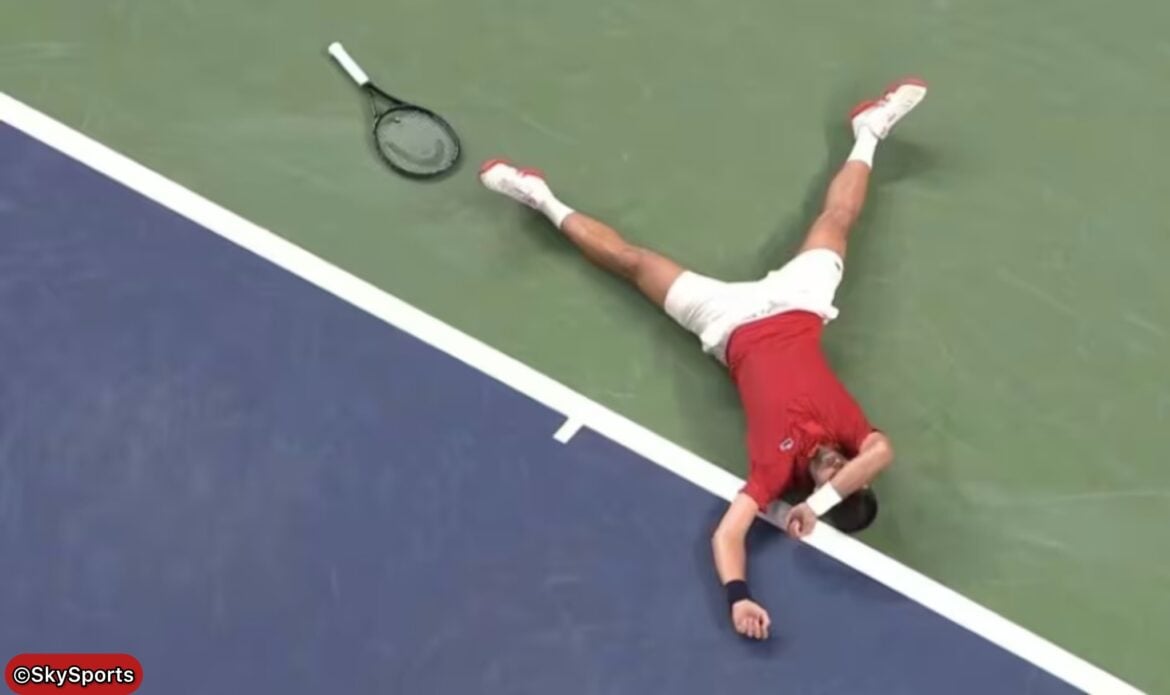Novak Djokovic collapsed to the floor in exhaustion during his round-of-16 match at the Shanghai Masters, as extreme heat and humidity pushed the tennis legend to breaking point.
The former world number one visibly struggled throughout his contest against Spain’s Jaume Munar, with the oppressive conditions forcing him to require medical attention during the third set. Concerned spectators watched as the 37-year-old Serbian star, drenched in sweat and gasping for breath, eventually slumped onto the court surface.
Tournament medics rushed to check Djokovic’s vital signs as he lay on the ground, highlighting the severity of the playing environment that has plagued this year’s Shanghai tournament. Humidity levels have remained close to 80 per cent throughout the week, whilst temperatures have consistently exceeded 30 degrees Celsius.
The 24-time Grand Slam champion had bent over repeatedly between points, clearly struggling to cope with the energy-sapping conditions before his dramatic collapse. Medical staff provided treatment during the changeover, allowing Djokovic time to recover before continuing the match.
Despite the physical ordeal, Djokovic managed to secure victory, defeating Munar 6-3, 5-7, 6-2 to advance to the quarter-finals. However, his struggle underscored growing concerns about player welfare in extreme weather conditions.
Speaking after the match, Djokovic admitted the brutal climate had pushed him beyond normal physical limits. He revealed he had vomited during his second fixture of the competition, demonstrating just how severely the conditions were affecting even the most conditioned athletes.
It’s brutal when you have over 80 per cent of humidity day after day, particularly for the guys playing during the day with the heat and the sun, it’s even more brutal,” Djokovic explained. “For me, biologically, it’s a bit more challenging to deal with it. But I had to really weather the storm today.”
The Serbian’s admission follows a wave of similar complaints from elite players competing across China in recent weeks. World number one Jannik Sinner was forced to retire from his opening match in Shanghai due to severe cramping brought on by the oppressive heat.
Other top players including Holger Rune and Casper Ruud have also struggled with the humid conditions, raising questions about whether tournaments are adequately protecting player health and safety.
Rune has been particularly vocal in calling for regulatory changes to address the problem. The Danish star believes tennis should implement a heat rule similar to those used at Grand Slam tournaments, where play can be suspended or modified when conditions become dangerously extreme.
“Yeah, I think there should be a heat rule like there are in the Grand Slam. I think every player would agree on that,” Rune said after his victory over Giovanni Mpetshi Perricard. “Today was better, as you say, today was less hot. But again, it was less hot, but if it was more normal temperature today would be very hot.”
The 21-year-old explained that whilst temperatures of 31 degrees Celsius might seem manageable in isolation, the combination with extreme humidity created dangerous playing conditions. “I think it was like 31 degrees and very humid. But compared to the other days it was pretty brutal,” he added.
Rune emphasised that whilst professional tennis players possess exceptional fitness and mental strength, there are physical limits that must be respected. “We can handle a certain amount of heat because, you know, we are fit, we’re strong, we’re mentally strong as well, but there’s always a limit,” he stated.
The Danish player stressed the importance of prioritising long-term health over short-term competitive considerations. “I think it’s also important to take care of your health. We need to survive,” Rune said, suggesting that current protocols may be placing players at unnecessary risk.
He advocated for adopting the Grand Slam model, where tournament officials have discretion to intervene when conditions become excessive. “I think some kind of rule, you know, not that we should stop if it’s just more than this, but like the Grand Slam, you know, they have a feeling on when it’s a little bit too much, and we wait a little bit to see if it drops,” Rune explained.
Grand Slam tournaments employ the Extreme Weather Policy, which allows matches to be suspended or moved when heat and humidity reach dangerous levels. The policy considers factors including temperature, humidity, wind speed, and solar radiation to calculate a composite risk assessment.
However, regular ATP Tour events like the Shanghai Masters operate under different rules, with less flexibility to modify schedules or suspend play based on weather conditions. This creates situations where players must compete in conditions that would trigger protective measures at major championships.
The sight of Djokovic, one of the fittest and most disciplined athletes in tennis history, collapsing from heat exhaustion has intensified calls for reform. If a player of his calibre and experience cannot safely compete in such conditions, critics argue, the system clearly requires adjustment.
Tennis already faces scrutiny over its demanding schedule, with players competing across multiple continents throughout the year in varying climatic conditions. The sport’s transition from traditional grass and clay surfaces to hard courts in extreme environments has raised additional health concerns.
China’s autumn tennis season typically offers more moderate conditions than summer tournaments, but climate patterns have become increasingly unpredictable. This year’s Shanghai Masters has coincided with an unseasonable heat wave that has caught organisers and players unprepared.
The ATP has yet to announce whether it will review its heat policies in response to the Shanghai incidents. However, with multiple top players publicly complaining and one of the sport’s greatest champions collapsing on court, pressure is mounting for regulatory changes to protect athlete welfare.
Follow for more updates on Britannia Daily



